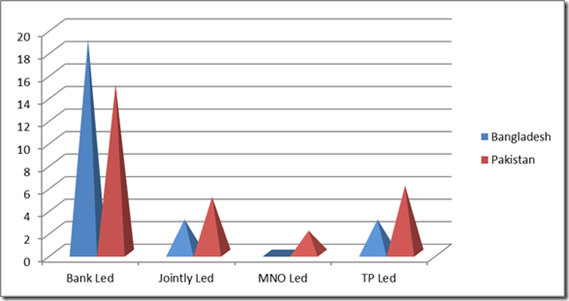In two previous blogs I discussed how branchless banking(BB) has taken off in Pakistan, and the way that the mobile and banking industries in Bangladesh are coming together to launch mobile financial services (MFS). This brings us to the logical question – how do they compare against each other? How is BB Pakistani style different to MFS a la Bangladesh? Which is likely to take off faster, and how are the people in each of the countries likely to benefit from the services?
Let’s start with the ways in which they are similar. Fundamentally they address a common problem – the need to provide banking services to the masses of unbanked population within the country, and to reduce the number of people living on less than $2 per day. Although Bangladesh started later, it claims to be catching up with Pakistan, with 1.3 million users as compared to 1.82 million in Pakistan. However it has less than half the number of agents, a smaller percentage of active users and also a smaller percentage of active agents.
One of the determinants of the “DNA” of Digital Money in a country is the regulatory approach to non-banks. In this respect, both countries favour a bank-based, bank-led approach. Let’s take a look at the business model behind the current initiatives developing in each country, drawing on Shift Thought analysis from our recently published 200 page+ reports on each country.
Figure 4: The business model behind DMI initiatives in Bangladesh and Pakistan
In Bangladesh we discovered that there were fewer initiatives that were driven by mobile network operators and third parties. Also, while in Pakistan mobile operators have partnered with MFI banks, or even set up their own such banks, this is not yet the case in Bangladesh. The more common model is banks obtaining the USSD gateway from mobile operators and availing of a “looser” partnering strategy.
What is most interesting is how this difference in the DNA is going to impact the growth of agent networks. Mobile operators have years of experience in setting up networks to top-up their prepaid user accounts. Will they drive as hard with less at stake? Also Bangladesh has a sizable task at hand in terms of putting an identity card in the hand of every citizen. This too needs a determined approach.
Despite any differences, we expect the real determinant will be the role of the government and various initiators of payments in each country. If this backs-up the achievements of the regulators, both markets are going to be exciting to watch over 2013.



Pingback: Digital Money | Malala’s vision and Digital Money | Digital Money